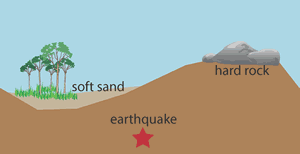
If you haven't done the Distance Effects topic yet, you should do that one first.
When learning about how distance affects shaking we learned that the waves lose energy as they travel. How fast they lose energy depends on the type of rock they are traveling through. For instance, very solid granites will transmit energy better than the chewed up rocks we find in fault zones. It's almost like the waves traveling through the chewed up rocks are traveling further and so they lose more energy and especially more of the high frequencies.
Below are two seismograms, or records of ground shaking, you can listen to. They come from the same earthquake but were recorded on two different seismometers. Both seismometers were about 5 miles from the earthquake, but one is on very solid rock while the other is in the fault zone. That's why they have different pitches. The volume has been adjusted to the same level so concentrate on the pitch to tell the difference. Click the sideways triangle (or play button) to hear the sound.
Seismometer One
Seismometer Two
Which seismometer was on the solid rock:
or ? Jump to Navigation
Jump to Navigation